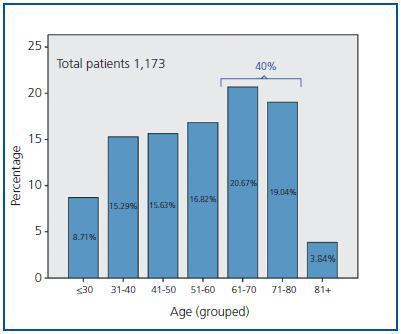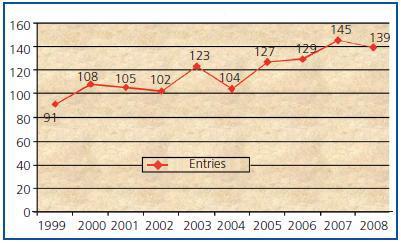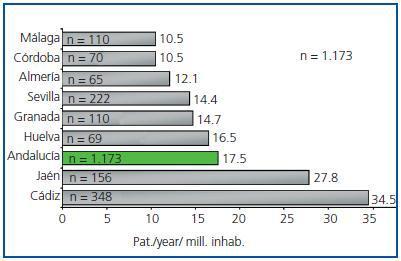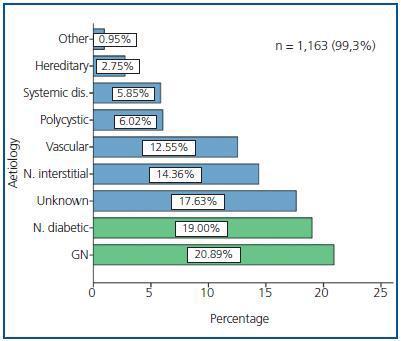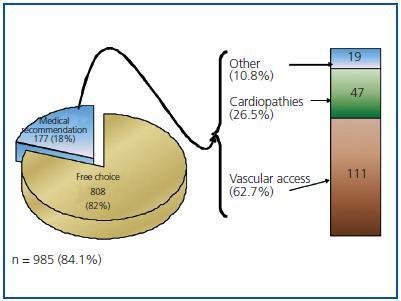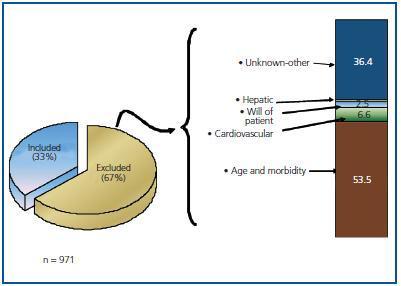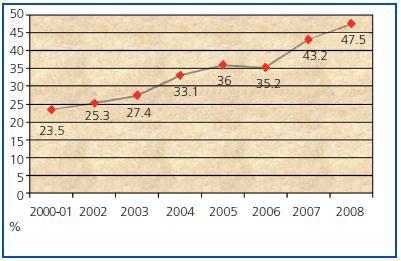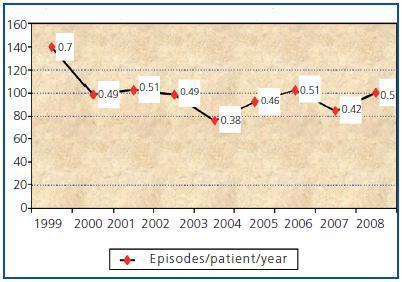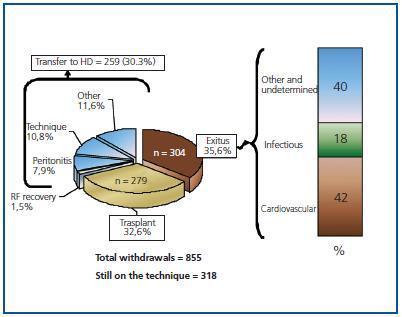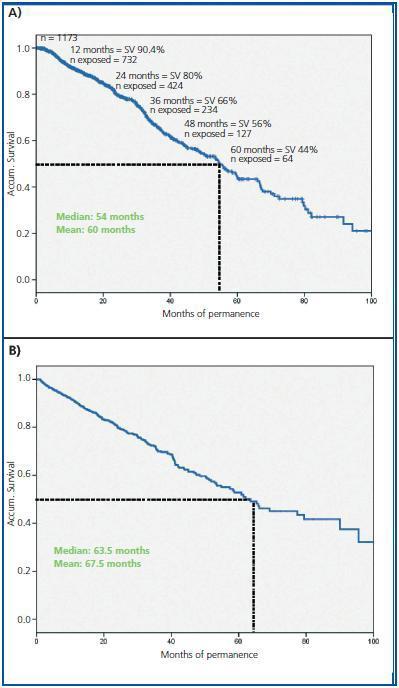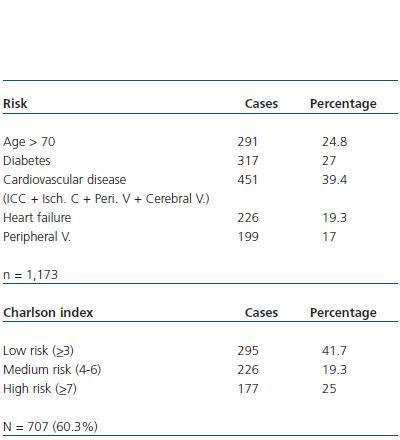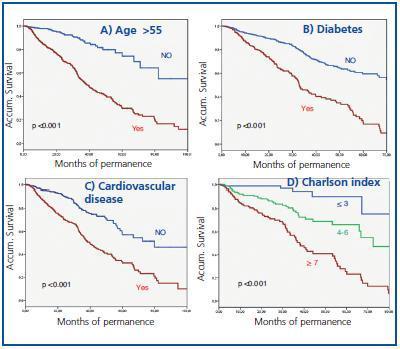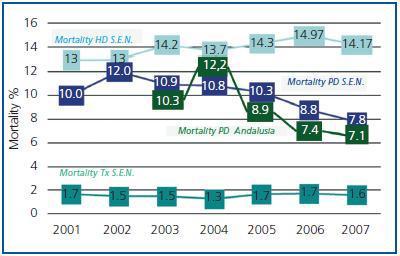In this study we show the results derived from the processing of the data of the Registry of the patients on peritoneal dialysis that initiated renal replacement therapy in Andalucía between January of 1999 and December of 2008. All the information comes from the base of the Registry of Renal Patients of the Andalucia´s Health Service. The results show demographic data, distribution by provinces, etiology of the end stage renal disease, reason for election of the peritoneal dialysis, inclusion or not in list of renal transplant, catheter data, withdraws and their causes, and peritonitis data of 2008. We also analyze in the report, from 1999-2008: anual incidence, diabetes, automatic peritoneal dialysis and peritonitis incidence. Finally we have studied patient and technique survival and factors affecting mortality on peritoneal dialysis, the initial comorbid conditions and its impact in the patient´s survival.
En este estudio presentamos todos los resultados derivados del procesamiento de los datos del registro de los pacientes de diálisis peritoneal que iniciaron tratamiento sustitutivo en Andalucía entre enero de 1999 y diciembre de 2008. Toda la información procede del Sistema de Información de la Coordinación Autonómica de Trasplante de Andalucía (SICATA). Se presentan datos demográficos, distribución por provincias, las causas de insuficiencia renal y motivo de elección de la diálisis peritoneal como técnica de tratamiento renal sustitutivo, la situación con respecto al trasplante, datos en relación con el catéter y técnica de diálisis peritoneal, las salidas del programa y sus causas, las peritonitis del año 2008, su evolución y resultado de los cultivos. Presentamos también en el informe datos evolutivos 1999-2008 en cuanto a inclusiones, diabetes, tratamiento con diálisis peritoneal automática e incidencia de peritonitis. Analizamos, por otra parte, la supervivencia global de los pacientes y de la técnica diálisis peritoneal, la comorbilidad al inicio del tratamiento y su impacto en la supervivencia.
INTRODUCTION
This report presents the results derived from the processing of data from the peritoneal dialysis (PD) module of the Information System for Regional Transplant Coordination in Andalusia (SICATA) of all patients included in this treatment in the period from 1 January 1999 to 31 December 2008.
The aim of this document is to provide relevant epidemiological information relating to PD patients, such as the number of patients treated in the period, demographic data, incident patients, aetiology of renal failure, distribution by age, types of catheter used, PD techniques, situation with respect to renal transplant, rate of peritonitis and germs, and the analysis of overall technique and patient survival, causes of treatment abandonment, comorbidity at onset and its impact on patient survival.
METHODS
Database
All information comes from the Peritoneal Dialysis Module of the Information System for Regional Transplant Coordination in Andalusia (Regional Ministry of Health of Andalusia). Since 1999, comorbidity has been recorded as the presence of the most common risk factors (age, diabetes, cardiovascular disease, neoplastic disease, liver disease, dyslipidemia, etc.). From 2004, the Charlson index1,2 has also been included at the start of treatment as a measure of comorbidity.
All hospitals with PD in the Community of Andalusia have participated in the completion of this database:
- Almería: Torrecárdenas Hospital.
- Cádiz: Hospital of Puerto Real. Puerta del Mar Hospital. Hospital of Jerez de la Frontera.
- Córdoba: Reina Sofía Hospital.
- Granada: Virgen de las Nieves Hospital. San Cecilio Hospital.
- Huelva: Juan Ramón Jiménez Hospital.
- Jaén: Medical-Surgical Hospital.
- Málaga: Carlos Haya Hospital.
- Seville: Virgen del Rocío Hospital. Virgen de Macarena Hospital.
Data Processing
This report has been produced with the data from all adult patients (> 14 years old) who began treatment on PD within the period from January 1999 to December 2008, and who have stayed on this technique for more than one month. The treatment population of 2008 has been analysed with respect to the incidence, aetiology and evolution of peritonitis.
The statistical analysis (SPSS.15) has been carried out through the use of: central tendency and dispersion measures (means and standard deviation) for quantitative variables; frequencies for qualitative variables; contingency tables, hypothesis tests, chi squared and Student t-test, determination of relative risks (RR) and confidence intervals (CI) to 95% for inferential statistics; and Kaplan-Meier survival curves and log-rank test for curve comparison. Finally, a multivariate Cox model has been used to adjust risk proportional to the included comorbidities.
RESULTS
Demographic data
The total number of patients included in the technique from 1 January 1999 to 31 December 2008 was 1,173. In the last 5 years, the percentage of incident patients on PD has not changed significantly with respect to other renal replacement treatments (2004: 11.1%; 2005: 10.1%; 2006: 10%; 2007: 10.1%; 2008: 13.1%).
57% are men (n = 669) and 43%, women (n = 504). The average age is 56 years (SD = 17), ranging between 15 and 90 years old. Distribution by age is shown in Figure 1, where we emphasise that 40% of patients start PD in the 61 to 80 age range.
During 2008, 419 patients were treated, and as of 31 December, 318 remained in the program. In that year, 139 new patients started PD in Andalusia, following a gently rising trend in the study period (Figure 2).
Most of patients who begin PD have not had any other previous renal replacement treatment (73.74%, n = 865). Of the 308 remaining patients (26.26%), 286 (24.38% of the total) transferred from HD. Although this percentage of previous HD may be considered relatively high, only 108 (9.21% of the total) were on this technique for more than 90 days and, therefore, the technique could be considered temporary or preparatory to PD in the 178 remaining patients (15.1% of the total). Finally, it should be pointed out that 22 patients (1.88% of the total who began PD) came from the loss of a previous kidney graft.
The distribution of incident patients on PD by province per million inhabitants in the 1999-2008 period (pat./year/mill.) shows the following data in descending order: Cádiz: 34.5; Jaén: 27.8; Huelva: 16.5; Granada: 14.7; Seville: 14.4; Almería: 12.1; Córdoba and Málaga: 10.5 (Figure 3). The mean in Andalusia is 17.5 pat./year/mill.
Causes of renal failure
Causal nephropathy is shown in Figure 4. Glomerulonephritis and diabetes constitute the primary aetiologies of renal failure in this population, followed by non-filiated causes.
Reason for selection of peritoneal dialysis
In 82% of patients, PD was freely chosen as renal replacement treatment. The remaining 18% opted for PD for medical reasons, predominantly due to vascular access problems (impossibility or exhaustion) and heart disease (Figure 5).
Transplant situation
33% of patients are included on the renal transplant waiting list. The main cause of exclusion from the list of the remaining 67% is advanced age and age-associated morbidity (Figure 6).
Catheter and peritoneal dialysis modalities
The most frequently implanted catheter was the Swan-Neck (52.4%), followed by the Tenckhoff straight, two-cuff catheter (25.2%) and single-cuff catheter (9.4%), the Toronto WH (4.6%) and others (8.3%). Implantation was performed surgically in 81% of cases and placement was predominantly paramedial (77.6%).
Continuous ambulatory peritoneal dialysis (CAPD) is the most used PD technique (57.9%). However, in recent years the percentage of patients included in automatic peritoneal dialysis techniques has been increasing considerably, reaching 47.5% of all patients in 2008 (Figure 7).
Peritonitis
This report presents a detailed analysis of peritonitis occurrences during 2008. A total of 170 cases were accounted for in that year, which, calculating the period of exposure to risk, corresponds to a rate of 0.50 episodes/patient/year, or expressed in another way, one peritonitis episode every 24 months. This is similar to the incidence figures of previous years (Figure 8).
Of the 170 peritonitis cases in 2008, a gram-positive germ grew in the culture of 54.6%, gram-negative in 27.6% and fungi in 1.2%. The peritonitis was polymicrobial in 4.8% of cases and no growth was detected (sterile peritonitis) or it was not recorded in 11.8% of cases. Peritonitis occurred with exit-site infection (ESI) in 7 cases (4.8%).
Evolution tended towards cure in the majority of cases (74.4%), relapse in 9.9% and removal of the catheter in 12.2%. In 6 cases the patient died in the following 4 week period (3.5%).
65 patients required hospitalisation due to this reason (45%), with a mean stay of 8.17 days (SD = 8.9 days; range, 1-60).
Causes for abandoning the program in the 1999-2008 period (Figure 9)
The total withdrawals from the PD program in Andalusia during the whole period were 855 patients, meaning that 318 were continuing on the technique as of 31 December 2008. The causes for abandonment were distributed almost equally in one third for patient death (35.6%), one third for kidney transplant (32.6%) and one third for transfer to haemodialysis (30.3%). Finally, 1.5% stopped the treatment due to recovery of kidney function.
Cardiovascular disease is the primary cause of death in patients included in PD in Andalusia (42%), followed by infections (18%).
Technique and patient survival
An inclusion criterium for the survival (SV) study was having been on the technique for at least one month. Withdrawals due to transplant, recovery of renal function or transfer to haemodialysis were considered follow-up losses, and the episode measured was withdrawal due to death. The overall actuarial survival curve shows the median SV of PD patients in Andalusia at 54 months (survival of 50% at 54 months). The mean is 60 months and 44% survival is observed at 5 years (Figure 10A).
We also calculated the gross annual mortality rate from 2003 to 2007 using the index that relates the deaths in each year to the total population exposed throughout that same year, with the following results: 2003, 10.3%; 2004, 12.2%; 2005, 8.9%; 2006, 7.4%, 2007, 7.1%.
SV of the PD technique (studied episode: transfer to haemodialysis) shows somewhat better results, with a median of 63.5 months and a mean of 67.5 months (Figure 10B).
Risk factors at start of technique and their influence on patient survival
Cardiovascular disease (defined as the presence of one or various of the following conditions: heart failure, ischaemic cardiopathy, cerebral vasculopathy or peripheral arteriopathy) was the most frequent risk factor, being present in 38.4% of patients who started PD, followed by diabetes mellitus (27%) and age of over 70 years (24.8%). If we analyze the Charlson index (taken in 707 patients; 60.3% of the total) we see that 41.7% have an index of less than 3, while 33.2% have a medium risk, with an index of 4 to 6, and 25% have a high risk (defined as an index of 7 or more) (Table 1).
A bivariate log-rank test was used to study the influence of these risk factors on patient survival: an age of more than 55 years at the start of PD (p < 0.001; Figure 11A), the presence of diabetes mellitus at that time (p < 0.001; Figure 11B), cardiovascular disease (p < 0.001; Figure 11C) or a higher Charlson index (p < 0.005; Figure 11D) are seen to be conditions for significantly worse survival.
Multivariate model
We used the Cox regression to evaluate the independence of the distinct risk factors to each other and their influence on survival. The significant factors were: a) age (treated as a continuous variable), with a Hazard Ratio (HR) of 1.040 (CI 95% of 1.029-1.050), that is, an increase in risk of 4% for each year older; b) cardiovascular disease (HR: 1.687; CI 95%: 1.290-2.205), and c) diabetes mellitus (HR: 1.905; CI 95%: 1.479-2.455) (Table 2).
DISCUSSION AND COMPARISON TO OTHER REGISTRIES
The use of PD in Andalusia is rare (incidence of 17.5 pat./year/mill. in the current report) if compared to the figures for haemodialysis (HD) in the same community and according to the dialysis and transplant report for 2005 from the Spanish Society of Nephrology (SEN in Spanish) (107 pat./year/mill.).3 This figure of incident patients per year and million inhabitants on PD is similar to the national mean, but lower than autonomous communities such as the Canary Islands, Cantabria and the Basque Country.3 However, there is a very heterogeneous distribution between provinces that is maintained over time in such a way that provinces like Cádiz and Jaén are above the national mean and in figures similar to the communities mentioned above.
Diabetes mellitus is the second cause of terminal chronic renal failure in PD in Andalusia, and would have been the first had glomerular disease not been considered as a separate entity. This is similar to the Spanish Registry published by the SEN for 2005.3
The percentage of patients included on the kidney transplant waiting list can be considered high and similar to that reported by other Spanish PD registries (Levante Registry). This percentage is higher in Andalusia than that of patients included in HD (data from the CKD Registry of the Community of Andalusia)4 and can be explained by the younger population with less comorbidity.
The rate of peritonitis in 2008 in Andalusia was 0.50 episodes/patient/year (one episode every 24 months/patient), a similar incidence to that of previous years. A stability is observed, with slight annual increases and decreases in this incidence in the study period (Figure 9). These rates are lower than the maximum admissible rate indicated by the International Peritoneal Dialysis Society Guidelines, which is one episode every 18 months (0.67 per year at risk).5 And although the rate of peritonitis depends on the characteristics of the treated population, it is still above what is considered the optimal rate of one episode every 40 to 50 months published by some authors.6,7
The most frequent reasons for leaving the technique are distributed almost evenly in thirds and correspond to patient death, renal transplant and technique failure. This distribution in patient withdrawal coincides with that reported previously by other authors.8,9
The overall survival of PD patients in Andalusia is 44% at 5 years (mean of 60 months and median of 54 months); this overall survival is similar to that published by the majority of Spanish10 and other European countries11,12 registries and is above registries in the USA.13 and the Australia–New Zealand registry (ANZDATA).14 However, mortality is significantly influenced by some of the characteristics of the treated population such as age and comorbidity,15 which we have also studied.
Firstly, the gross annual mortality rate of the Andalusian PD population was calculated with the aim of comparing it to those published by the SEN’s Spanish Registry of Dialysis and Transplant,16 observing similar values between PD in Andalusia and SEN, with a tendency to lesser mortality in the last 5 years (Figure 12).
The annual mortality rates of PD (Andalusia and SEN) are lower than those reported by the SEN for HD in the same periods. However, these analyses are not adjusted to comorbidity, and this difference may be explained by the lower age and lesser comorbidity of patients on PD.
In this study a multivariate adjustment has been made through the construction of a Cox regression model to evaluate the influence of comorbidity and age on the survival of PD patients in Andalusia. In our population, as previously described by other authors,17-19 the principal independent factors for the patient’s prognosis are age and comorbidity derived from cardiovascular disease and diabetes mellitus present before the start of renal replacement treatment.
Acknowledgements
We are grateful to the technicians of the Regional Transplant Coordination Office of Andalusia, especially to César Remón García, computer technician with INDRA, for his collaboration in the programming and maintenance of the Database.
Figure 1. Distribution by age group (1999-2008).
Figure 2. Evolution of annual entrants in the period 1999-2008.
Figure 3. Distribution by province, referring to entries by province per year and million inhabitants.
Figure 4. Causal nephropathy (n = 1,163 [99.3%]).
Figure 5. Reason for choosing PD.
Figure 6. Transplant situation.
Figure 7. Annual percentage of patients on automatic peritoneal dialysis (APD).
Figure 8. Incidence of peritonitis per year.
Figure 9. Abandonment of the technique and causes.
Figure 10. Overall survival of patients (A) and technique (B) in PD in Andalusia. Period 1999-2008.
Table 1. Risk factors at start of PD
Figure 11. Influence of risk factors on patient survival (log-rank test).
Table 2. Cox multivariate regression model
Figure 12. Comparison of gross annual mortality rates: HD, PD and TX according to the Spanish Registry of the SEN and of PD in Andalusia.


